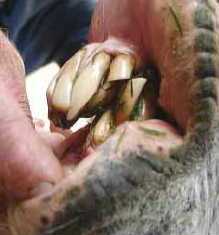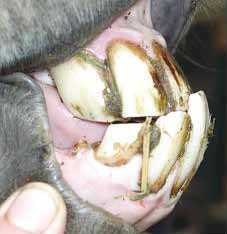Incisor Teeth Disorders - Donkey
Introduction
Compared to the cheek teeth, the incisors rarely suffer significant disorders. However, as these teeth are easily examined without a gag, even minor problems are apparent, which is in great contrast to the cheek teeth.
Brachygnathism and Prognathism


Occasionally donkeys have a degree of brachygnathism (‘parrot mouth,’ ‘overshot jaw’, overjet or overbite). However, unless contact between opposing incisors is totally absent, this condition rarely causes the donkey trouble in eating. If major overgrowths do occur on the upper incisors in parrot-mouthed donkeys (in the presence of unopposed incisors) these overgrown upper incisors can lie in front of, and therefore trap, the lower incisors. This may even retard the growth of the mandible and cause secondary disorders of the cheek teeth.
Prognathism (‘sow mouth,’ ‘undershot jaw’ or underbite) is very uncommon in the donkey and is usually insignificant, unless there is total lack of occlusion between teeth. Major incisor overgrowths should be rasped level twice yearly. In contrast to cheek teeth floating, many donkeys greatly resent incisor teeth floating and require sedation (and therefore veterinary attention) for this procedure. Care should be taken not to expose incisor teeth pulp chambers when levelling overgrown teeth, and it may be advisable to perform such reductions in more than one session.
Retained deciduous incisors
Deciduous (milk/temporary) incisors are occasionally retained (in front of permanent incisors – i.e. labial aspect) and this can cause the erupting permanent incisors to be displaced caudally and in some cases will cause permanent changes to the incisor wear pattern. If the retained deciduous incisors are very loose they may be removed with the fingers. If firmly attached, they will need to be extracted under sedation and local anaesthesia, especially if they are interfering with the normal eruption of the permanent teeth.
Supernumerary permanent incisors
Supernumerary permanent incisors (teeth that are additional to the normal six incisors on each arcade) have long reserve crowns that are usually intimately related to the reserve crowns and roots of the normal permanent incisors. Consequently, extraction of these supernumerary teeth is both very difficult and risks damaging normal teeth. As supernumerary incisor teeth cause few clinical problems (unless grossly displaced), they are usually left alone with twice-yearly rasping of these teeth performed to prevent overgrowths developing.
Fractures
Fractures of the incisor teeth can occur due to external trauma, and commonly result in exposure of the pulp cavities. The teeth of young donkeys contain very wide apical foraminae (root canal openings) and have very large and vascular pulps that can resist the pulpar inflammation associated with infection upon exposure to the oral cavity. Consequently, pulp exposure, especially in younger donkeys, does not necessarily lead to tooth loss caused by pulpar death, as would usually occur with pulp exposure in brachydont (e.g. human or canine) dentition. In many donkeys, the pulp will become sealed off at the site of exposure by reparative (tertiary) dentine formation, with the tooth remaining vital (healthy) and continuing to erupt normally. The opposite incisor, having nothing to wear against, will tend to overgrow and so should be rasped twice yearly, otherwise this overgrown tooth may ‘lock’ into the space above the shortened fractured tooth and prevent normal side-to-side jaw movements. Endodontic (root canal) treatment can be performed on exposed pulp chambers by specialist veterinary surgeons but the long-term efficacy of this treatment has yet to be assessed. Crib-biting causes abnormal wear on the rostral aspect of incisors and occasionally results in fractures. All dental fracture cases need veterinary attention, which may include tetanus anti-serum and prolonged antibiotic therapy.
Occlusal surface abnormalities
Abnormalities of the occlusal (grinding) surfaces of the incisors may include ‘steps’, due to the loss, partial fracture or maleruption of opposing teeth (delayed or other abnormalities of eruption). Abnormalities of wear may cause a convex appearance of the upper incisor occlusal surface (‘smile’ or ‘seagull’) occasionally in ‘parrot-mouthed’ donkeys, or concave (‘frown’) in ‘sow-mouthed’ donkeys. A ‘tilted’ or ‘slant’ mouthshaped occlusal incisor surface will develop in donkeys chewing in only one direction, usually due to a painful or mechanically obstructive lesion on one side of the mouth. Only rarely will major incisor abnormalities prevent normal occlusion of the cheek teeth and lead to difficulties in prehension (grasping food) or mastication. Incisor irregularities should first be carefully assessed and any predisposing cheek teeth abnormalities should also be diagnosed and treated. Large incisor irregularities should be reduced, probably using sedation and power tools, and this should be performed in stages if major incisor overgrowths are present.
References
- Dacre, I., Dixon, P. and Gosden, L. (2008) Dental problems In Svendsen, E.D., Duncan, J. and Hadrill, D. (2008) The Professional Handbook of the Donkey, 4th edition, Whittet Books, Chapter 5
|
|
This section was sponsored and content provided by THE DONKEY SANCTUARY |
|---|